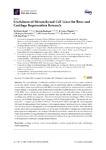Mostrar o rexistro simple do ítem
Usefulness of mesenchymal cell lines for bone and cartilage regeneration research
| dc.contributor.author | Piñeiro-Ramil, María | |
| dc.contributor.author | Sanjurjo-Rodríguez, Clara | |
| dc.contributor.author | Castro Viñuelas, Rocío | |
| dc.contributor.author | Rodríguez-Fernández, Silvia | |
| dc.contributor.author | Fuentes Boquete, Isaac Manuel | |
| dc.contributor.author | Blanco García, Francisco J | |
| dc.contributor.author | Díaz-Prado, Silvia | |
| dc.date.accessioned | 2020-01-09T10:22:24Z | |
| dc.date.available | 2020-01-09T10:22:24Z | |
| dc.date.issued | 2019-12-13 | |
| dc.identifier.citation | Piñeiro-Ramil M, Sanjurjo-Rodríguez C, Castro-Viñuelas R, Rodríguez-Fernández S, Fuentes-Boquete I, Blanco F, Díaz-Prado S. Usefulness of mesenchymal cell lines for bone and cartilage regeneration research. Int J Mol Sci. 2019;20(24):6286 | es_ES |
| dc.identifier.issn | 14220067 | |
| dc.identifier.uri | http://hdl.handle.net/2183/24581 | |
| dc.description.abstract | [Abstract] The unavailability of sufficient numbers of human primary cells is a major roadblock for in vitro repair of bone and/or cartilage, and for performing disease modelling experiments. Immortalized mesenchymal stromal cells (iMSCs) may be employed as a research tool for avoiding these problems. The purpose of this review was to revise the available literature on the characteristics of the iMSC lines, paying special attention to the maintenance of the phenotype of the primary cells from which they were derived, and whether they are effectively useful for in vitro disease modeling and cell therapy purposes. This review was performed by searching on Web of Science, Scopus, and PubMed databases from 1 January 2015 to 30 September 2019. The keywords used were ALL = (mesenchymal AND (“cell line” OR immortal*) AND (cartilage OR chondrogenesis OR bone OR osteogenesis) AND human). Only original research studies in which a human iMSC line was employed for osteogenesis or chondrogenesis experiments were included. After describing the success of the immortalization protocol, we focused on the iMSCs maintenance of the parental phenotype and multipotency. According to the literature revised, it seems that the maintenance of these characteristics is not guaranteed by immortalization, and that careful selection and validation of clones with particular characteristics is necessary for taking advantage of the full potential of iMSC to be employed in bone and cartilage-related research. | es_ES |
| dc.description.sponsorship | This study was carried out thanks to the funding from Rede Galega de Terapia Celular and Grupos con Potencial de Crecemento, Xunta de Galicia (R2016/036, R2014/050, CN2012/142 and GPC2014/048); Deputación da Coruña (BINV-CS/2016); Fundación Española de Reumatología (Proyectos 2014); Universidade da Coruña (UDC) and Centro de Investigación Biomédica en Red-Bioingeniería, Biomateriales y Nanomedicina (CIBER-BBN). | |
| dc.description.sponsorship | Xunta de Galicia; R2016/036 | |
| dc.description.sponsorship | Xunta de Galicia; R2014/050 | |
| dc.description.sponsorship | Xunta de Galicia; CN2012/142 | |
| dc.description.sponsorship | Xunta de Galicia; GPC2014/048 | |
| dc.description.sponsorship | Deputación da Coruña; BINV-CS/2016 | |
| dc.language.iso | eng | es_ES |
| dc.publisher | MDPI | es_ES |
| dc.relation.uri | https://doi.org/10.3390/ijms20246286 | es_ES |
| dc.rights | Creative Commons Attribution 4.0 International Licence (CC-BY 4.0) | es_ES |
| dc.rights.uri | http://creativecommons.org/licenses/by/4.0/ | * |
| dc.subject | Cartilage and bone repair | es_ES |
| dc.subject | Immortalization | es_ES |
| dc.subject | Mesenchymal stromal cells | es_ES |
| dc.subject | Cell therapy | es_ES |
| dc.subject | Tissue engineering | es_ES |
| dc.title | Usefulness of mesenchymal cell lines for bone and cartilage regeneration research | es_ES |
| dc.type | info:eu-repo/semantics/article | es_ES |
| dc.rights.access | info:eu-repo/semantics/openAccess | es_ES |
| UDC.journalTitle | International journal of molecular sciences | es_ES |
| UDC.volume | 20 | es_ES |
| UDC.issue | 24 | es_ES |
Ficheiros no ítem
Este ítem aparece na(s) seguinte(s) colección(s)
-
GI-TCMR - Artigos [123]
-
INIBIC-TCMR - Artigos [102]
-
INIBIC- REUMA - Artigos [182]






